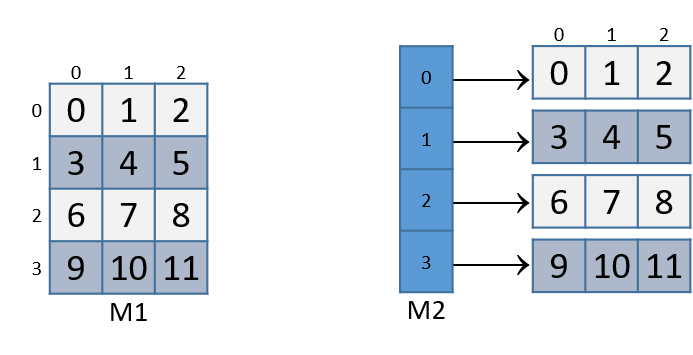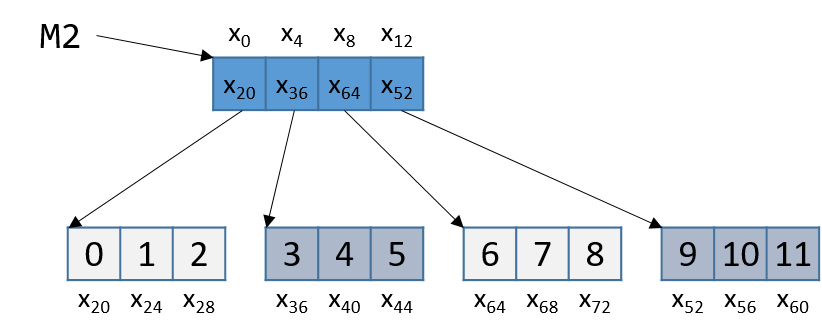8.8. Matrices
A matrix is a two-dimensional (2D) array. A matrix in the C language can be
statically allocated as a 2D array (M[n][m]), dynamically
allocated with a single call to malloc, or dynamically allocated as an
array of arrays. Let’s consider the array of arrays implementation. The first
array contains n elements (M[n]), and each element M[i] in our matrix
contains an array of m elements. The following code snippets each declare
matrices of size 4 × 3:
//statically allocated matrix (allocated on stack)
int M1[4][3];
//dynamically allocated matrix (programmer friendly, allocated on heap)
int **M2, i;
M2 = malloc(4 * sizeof(int*));
for (i = 0; i < 4; i++) {
M2[i] = malloc(3 * sizeof(int));
}In the case of the dynamically allocated matrix, the main array contains a contiguous array of int pointers. Each integer
pointer points to a different array in memory. Figure 1 illustrates how we would normally visualize each of these matrices.

For both of these matrix declarations, element (i,j) can be accessed
using the double-indexing syntax M[i][j], where M is either M1 or M2.
However, these matrices are organized differently in memory. Even though both store
the elements in their primary array contiguously in memory, our statically
allocated matrix also stores all the rows contiguously in memory, as shown in
Figure 2.

This contiguous ordering is not guaranteed for M2.
Recall that to
contiguously allocate an n × m matrix on the heap, we should use a single
call to malloc that allocates n × m elements:
//dynamic matrix (allocated on heap, memory efficient way)
#define ROWS 4
#define COLS 3
int *M3;
M3 = malloc(ROWS * COLS * sizeof(int));Recall that with the declaration of M3, element (i,j) cannot be accessed using the M[i][j] notation. Instead,
we must index the element using the format M3[i*cols + j].
8.8.1. Contiguous Two-Dimensional Arrays
Consider a function sumMat that takes a pointer to a contiguously allocated (either statically allocated or
memory-efficiently dynamically allocated) matrix as its first parameter, along with the numbers of rows and columns,
and returns the sum of all the elements inside the matrix.
We use scaled indexing in the code snippet that follows because it applies to both statically and dynamically allocated contiguous matrices.
Recall that the syntax m[i][j] does not work with the memory-efficient contiguous dynamic allocation previously discussed.
int sumMat(int *m, int rows, int cols) {
int i, j, total = 0;
for (i = 0; i < rows; i++){
for (j = 0; j < cols; j++){
total += m[i*cols + j];
}
}
return total;
}Here is the corresponding assembly. Each line is annotated with its English translation:
<sumMat>: 0x08048507 <+0>: push %ebp #save ebp 0x08048508 <+1>: mov %esp,%ebp #update ebp (new stack frame) 0x0804850a <+3>: sub $0x10,%esp #add 4 more spaces to stack frame 0x0804850d <+6>: movl $0x0,-0xc(%ebp) #copy 0 to ebp-12 (total) 0x08048514 <+13>: movl $0x0,-0x4(%ebp) #copy 0 to ebp-4 (i) 0x0804851b <+20>: jmp 0x8048555 <sumMat+78> #goto <sumMat+78> 0x0804851d <+22>: movl $0x0,-0x8(%ebp) #copy 0 to ebp-8 (j) 0x08048524 <+29>: jmp 0x8048549 <sumMat+66> #goto <sumMat+66> 0x08048526 <+31>: mov -0x4(%ebp),%eax #copy i to eax 0x08048529 <+34>: imul 0x10(%ebp),%eax #multiply i * cols, place in eax 0x0804852d <+38>: mov %eax,%edx #copy i*cols to edx 0x0804852f <+40>: mov -0x8(%ebp),%eax #copy j to %eax 0x08048532 <+43>: add %edx,%eax #add i*cols with j, place in eax 0x08048534 <+45>: lea 0x0(,%eax,4),%edx #mult (i*cols+j) by 4,put in edx 0x0804853b <+52>: mov 0x8(%ebp),%eax #copy m pointer to eax 0x0804853e <+55>: add %edx,%eax #add m to (i*cols+j)*4,put in eax 0x08048540 <+57>: mov (%eax),%eax #copy m[i*cols+j] to eax 0x08048542 <+59>: add %eax,-0xc(%ebp) #add eax to total 0x08048545 <+62>: addl $0x1,-0x8(%ebp) #increment j by 1 (j+=1) 0x08048549 <+66>: mov -0x8(%ebp),%eax #copy j to eax 0x0804854c <+69>: cmp 0x10(%ebp),%eax #compare j with cols 0x0804854f <+72>: jl 0x8048526 <sumMat+31> #if (j < cols) goto <sumMat+31> 0x08048551 <+74>: addl $0x1,-0x4(%ebp) #add 1 to i (i+=1) 0x08048555 <+78>: mov -0x4(%ebp),%eax #copy i to eax 0x08048558 <+81>: cmp 0xc(%ebp),%eax #compare i with rows 0x0804855b <+84>: jl 0x804851d <sumMat+22> #if (i < rows) goto sumMat+22 0x0804855d <+86>: mov -0xc(%ebp),%eax #copy total to eax 0x08048560 <+89>: leave #prepare to leave the function 0x08048561 <+90>: ret #return total
The local variables i, j, and total are loaded at addresses %ebp-4,
%ebp-8, and %ebp-12 on the stack, respectively. The input parameters m,
row, and cols are located at locations %ebp+8, %ebp+12, and %ebp+16,
respectively. Using this knowledge, let’s zoom in on the component that just
deals with the access of element (i,j) in our matrix:
0x08048526 <+31>: mov -0x4(%ebp),%eax # copy i to eax 0x08048529 <+34>: imul 0x10(%ebp),%eax # multiply i with cols, place in eax 0x0804852d <+38>: mov %eax,%edx # copy i*cols to edx
The first set of instructions computes i * cols and places the result in
register %edx. Recall that for a matrix named matrix, matrix + (i * cols)
is equivalent to &matrix[i].
0x0804852f <+40>: mov -0x8(%ebp),%eax # copy j to eax 0x08048532 <+43>: add %edx,%eax # add i*cols with j, place in eax 0x08048534 <+45>: lea 0x0(,%eax,4),%edx # multiply (i*cols+j) by 4, put in edx
The next set of instructions computes (i * cols + j) * 4. The compiler
multiplies the index (i * cols) + j by four because each element in the matrix
is a four-byte integer, and this multiplication enables the compiler to
calculate the correct offset.
The last set of instructions adds the calculated offset to the matrix pointer and dereferences it to yield the value of element (i,j):
0x0804853b <+52>: mov 0x8(%ebp),%eax # copy m pointer to eax 0x0804853e <+55>: add %edx,%eax # add m to (i*cols+j)*4, place in eax 0x08048540 <+57>: mov (%eax),%eax # copy m[i*cols+j] to eax 0x08048542 <+59>: add %eax,-0xc(%ebp) # add eax to total
The first instruction loads the address of matrix m into register %eax. The
add instruction adds the offset (i*cols + j)*4 to the address of m to
correctly calculate the address of element (i,j), and then places this address
in register %eax. The third instruction dereferences %eax and places the
resulting value in register %eax. The last instruction adds the value in
%eax to the accumulator total, which is located at stack address
%ebp-0xc.
Let’s consider how element (1,2) is accessed in Figure 2.

Element (1,2) is located at address M1 + (1 * COLS) + 2. Since COLS = 3,
element (1,2) corresponds to M1+5. To access the element at this location,
the compiler must multiply 5 by the size of the int data type (four bytes),
yielding the offset M1 + 20, which corresponds to byte x20 in the figure.
Dereferencing this location yields element 5, which is indeed element (1,2) in
the matrix.
8.8.2. Noncontiguous Matrix
The noncontiguous matrix implementation is a bit more complicated.
Figure 4 visualizes how M2 may be laid out in memory.

Notice that the array of pointers is contiguous, and that each array pointed to
by an element of M2 (e.g., M2[i]) is contiguous. However, the individual
arrays are not contiguous with one another.
The sumMatrix function in the following example takes an array of integer pointers (called
matrix) as its first parameter, and a number of rows and columns as its
second and third parameters:
int sumMatrix(int **matrix, int rows, int cols) {
int i, j, total=0;
for (i = 0; i < rows; i++) {
for (j = 0; j < cols; j++) {
total += matrix[i][j];
}
}
return total;
}Even though this function looks nearly identical to the sumMat function shown
earlier, the matrix accepted by this function consists of a contiguous array of
pointers. Each pointer contains the address of a separate contiguous array,
which corresponds to a separate row in the matrix.
The corresponding assembly for sumMatrix follows. Each line is annotated
with its English translation.
0x080484ad <+0>: push %ebp # save ebp 0x080484ae <+1>: mov %esp,%ebp # update ebp (new stack frame) 0x080484b0 <+3>: sub $0x10,%esp # add 4 spaces to stack frame 0x080484b3 <+6>: movl $0x0,-0xc(%ebp) # copy 0 to %ebp-12 (total) 0x080484ba <+13>: movl $0x0,-0x4(%ebp) # copy 0 to %ebp-4 (i) 0x080484c1 <+20>: jmp 0x80484fa <sumMatrix+77> # goto <sumMatrix+77> 0x080484c3 <+22>: movl $0x0,-0x8(%ebp) # copy 0 to %ebp-8 (j) 0x080484ca <+29>: jmp 0x80484ee <sumMatrix+65> # goto <sumMatrix+65> 0x080484cc <+31>: mov -0x4(%ebp),%eax # copy i to %eax 0x080484cf <+34>: lea 0x0(,%eax,4),%edx # mult i by 4, place in %edx 0x080484d6 <+41>: mov 0x8(%ebp),%eax # copy matrix to %eax 0x080484d9 <+44>: add %edx,%eax # put (i * 4) + matrix in %eax 0x080484db <+46>: mov (%eax),%eax # copy matrix[i] to %eax 0x080484dd <+48>: mov -0x8(%ebp),%edx # copy j to %edx 0x080484e0 <+51>: shl $0x2,%edx # mult j by 4, place in %edx 0x080484e3 <+54>: add %edx,%eax # put (j*4)+matrix[i] in %eax 0x080484e5 <+56>: mov (%eax),%eax # copy matrix[i][j] to %eax 0x080484e7 <+58>: add %eax,-0xc(%ebp) # add matrix[i][j] to total 0x080484ea <+61>: addl $0x1,-0x8(%ebp) # add 1 to j (j+=1) 0x080484ee <+65>: mov -0x8(%ebp),%eax # copy j to %eax 0x080484f1 <+68>: cmp 0x10(%ebp),%eax # compare j with cols 0x080484f4 <+71>: jl 0x80484cc <sumMatrix+31> # if j<cols goto<sumMatrix+31> 0x080484f6 <+73>: addl $0x1,-0x4(%ebp) # add 1 to i (i+=1) 0x080484fa <+77>: mov -0x4(%ebp),%eax # copy i to %eax 0x080484fd <+80>: cmp 0xc(%ebp),%eax # compare i with rows 0x08048500 <+83>: jl 0x80484c3 <sumMatrix+22> # if i<rows goto<sumMatrix+22> 0x08048502 <+85>: mov -0xc(%ebp),%eax # copy total to %eax 0x08048505 <+88>: leave # prepare to leave function 0x08048506 <+89>: ret # return total
Again, the variables i, j, and total are at stack addresses
%ebp-4, %ebp-8, and %ebp-12, respectively. The input parameters
m, row, and cols are located at stack addresses %ebp+8, %ebp+12, and
%ebp+16, respectively.
Let’s zoom in on the section that deals specifically with an access to element
(i,j), or matrix[i][j]:
0x080484cc <+31>: mov -0x4(%ebp),%eax # copy i to %eax 0x080484cf <+34>: lea 0x0(,%eax,4),%edx # multiply i by 4, place in %edx 0x080484d6 <+41>: mov 0x8(%ebp),%eax # copy matrix to %eax 0x080484d9 <+44>: add %edx,%eax # add i*4 to matrix, place in %eax 0x080484db <+46>: mov (%eax),%eax # copy matrix[i] to %eax
The five instructions between <sumMatrix+31> and <sumMatrix+46> compute
matrix[i], or *(matrix+i). Note that the compiler needs to multiply i by
four prior to adding it to matrix to calculate the correct offset (recall
that pointers are four bytes in size). The instruction at <sumMatrix+46> then
dereferences the calculated address to get the element matrix[i].
Since matrix is an array of int pointers, the element located at
matrix[i] is itself an int pointer. The jth element in matrix[i] is
located at offset j×4 in the matrix[i] array.
The next set of instructions extract the jth element in array matrix[i]:
0x080484dd <+48>: mov -0x8(%ebp),%edx # copy j to %edx 0x080484e0 <+51>: shl $0x2,%edx # multiply j by 4, place in %edx 0x080484e3 <+54>: add %edx,%eax # add j*4 to matrix[i], place in %eax 0x080484e5 <+56>: mov (%eax),%eax # copy matrix[i][j] to %eax 0x080484e7 <+58>: add %eax,-0xc(%ebp) # add matrix[i][j] to total
The first instruction in this snippet loads variable j into register %edx.
The compiler uses the left shift (shl) instruction to multiply j by four
and stores the result in register %edx. The compiler then adds the resulting
value to the address located in matrix[i] to get the address of
matrix[i][j].
Let’s revisit Figure 4 and consider an example access to
M2[1][2]. For convenience, we reproduce the figure in Figure 5.

Note that M2 starts at memory location x0. The compiler first computes the
address of M2[1] by multiplying 1 by 4 (sizeof(int *)) and adding it to the
address of M2 (x0), yielding the new address x4. A dereference of this
address yields the address associated with M2[1], or x36. The compiler
then multiplies index 2 by 4 (sizeof(int)), and adds the result (8) to
x36, yielding a final address of x44. The address x44 is dereferenced,
yielding the value 5. Sure enough, the element in Figure 5 that
corresponds to M2[1][2] has the value 5.